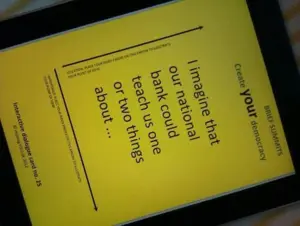A blog about leadership: Take employee engagement to a higher level
Call for price
+45 71 92 55 63
Take employee engagement to a higher level
This article sheds light on why your employees are uninvolved in the job and in the tasks. At the same time, the article sheds light on how you can engage them all in the tasks and in the collaboration. So - why and how.
But first a few words about your employees, which I initially call uninvolved. I do not know exactly if it is your employees who are uninvolved. From Gallup's survey State of the Global Workplace Report, 4 out of 5 employees in Denmark are uninvolved. By 'uninvolved' is meant uninterested and uncommitted. This means that these 80% of all employees in Denmark are not significantly interested in the job and in their colleagues and that they do not take on a binding responsibility for the tasks and for the colleagues. These are serious figures Gallup presents. They have done this on several occasions. And in Denmark we are even high. If you would like a copy of the Gallup report, write to michael@LEADERSwarehouse.com and I will send you a pdf.
Disengagement is seen as indifference, disinterest, slowness, passivity, impaired listening, uninspiration, stress symptoms, headaches, outbursts of anger, abandonment and much, much more in that street.
Personally, I meet 1 of the 4 uninvolved when I am out buying building materials. I often have questions about what I am buying and looking for an employee. When I find one, they stand with music in their ears and must first call a colleague who never shows up. Then I leave the store with unresolved case and buy my materials somewhere else.
I meet 1 of the 4 uninvolved when I contact the electricity company about father-in-law's unpaid bills that have just been forwarded to a debt collection agency. Three times I talk to a new employee before I get a concrete message. Today, one can switch electricity company and hope that the new company is better at talking to the customers.
I meet 1 of the 4 uninvolved when I stand in line at the bakery and the clerks do not quite have control of the customer order and I get skipped even though I stand with number 49 in hand. I can buy my baked bread elsewhere.
I meet 1 of the 4 uninvolved when I have to order a hot dog and the sausage man is in the middle of a gap. Hot dogs can be purchased on many street corners. It must be possible to find a sausage man who has got his well-deserved sleep.
I meet the 5th committed employee in a completely different construction market when the employee helps me with tips and tricks about the product and briefly tells how he himself uses it. I happily recommend this construction market to anyone who is just standing and needs a construction item.
Going to work and taking an interest in numbers, columns, stock lists, weekly meetings, colleagues and summer seminars is something the manager needs to initiate and maintain.
The basic commitment to the job itself is created by the manager in the interviews that take place before, during and after the employment. The employee is then pampered with a contract. Staff benefits are emerging. There is a desk ready. There are toilets, PCs, telephones and lunch room and coffee machine. The salary starts to flow into the account.
Should the manager then spend more time engaging the employees?
The answer is YES
In this article you will be told both 'why' and also 'how' the manager builds on the foundation of the 'employment circumstances'. The employment contract, salary and benefits can not make employees want to show up and participate in a task. Even the best cup of coffee on the market can not give employees a belief that the work is useful. Not even a brand new raise-lower desk and the latest mobile phone can give employees a willingness to provide and to help each other along the way. Not even a lunch arrangement with the highest-order pieces of open sandwiches can make employees appreciate each other, the team, and the manager.
The contract, the coffee, the desk and the daily lunch can possibly embellish the employment relationship. But so is it. So what is it that engages employees in the job - from task to task?
There is a new path that will lift the commitment to new heights
There is another way. And it's new. And no one knew it was there. It's called 'Motivate the whole team's commitment from task to task.'
Of a title to be, it might be a little long. But it says quite a lot about the practice. And then it is in Danish. Motivate them all at once and at once. We have also given it a smart name. But that does not change the outcome. We call it 'Strategic Motivation'. We do this because what is really happening is called 'motivation' and when it happens, as a result of some considerations and a series of plans, both in the short and long term, it is 'Strategic Motivation'.
Why motivate everyone from task to task?
The answer to the question is that of course there are no people who are committed to work tasks that do not have their natural interest. They get money to solve the tasks, and that is in fact the clearest expression that the tasks have no interest in anyone at all. That's why we pay them salaries, pour them coffee, set up desks, design beautiful canteens, hang art on the walls and invite to sumptuous summer parties and Christmas lunches. Employees are paid to take an interest.
Volunteer and unpaid jobs, such as those at music festivals, for example, are occupied by people who are passionate about making a difference and who want to meet a lot of other fun people and also want to listen to some music. These volunteers do not need a salary, desk or a nice canteen.
But with paid jobs, the reality is quite different.
It should also be mentioned that commitment also matters to colleagues, to customers, to society, to Europe, to the planet. The commitment to the job and to the tasks and to the collaboration must make sense for the individual employee, but it must also make sense for the customers and the surrounding community. The individual employee is not just a cog, but is an important and significant part of a community that helps clients and customers succeed. That is why it is so incredibly important that the individual employee is committed and that the entire team is committed. It applies to the individual and it applies to the whole.
So how does the leader do that?
Some say that there are no quick fixes, ie tools or methods that in record time repair and repair and do everything well. I think they exist, but they are mostly mechanical. Motivation of employee engagement is not mechanics. It's equal parts WHY and HOW. It consists of a basic understanding of WHY it is important to motivate employees' commitment from task to task. And then at the same time understand HOW.
Our new motivation model will give you a description of the procedure. But first you have to confess to being a democratic leader. You’ve probably heard of the three basic ways to lead. There is the democratic, the authoritarian and so laissez faire leadership.
The authoritarian leader says, 'Do as I please.'
The Laissez faire leader says, 'Do as you please.'
The Democratic leader says, 'Do as we please.'
As a democratic leader, you involve the employees. You provide free opportunities to solve the tasks. You are listening and cooperating. Then you are well on your way. At the same time, you need to know that whatever you emit by behavior, you get back from the employees. When you have small furious movements. When you shake your head. When you have a little too quick comments. Everything you get back again. Just like when you throw a boomerang. It's coming back. We also know the phrase 'Smile to the world and the world smiles to you.'
The leader is a boomerang. Everything the manager does and says comes back
When you as a manager know that everything you do and say comes back to you from the employees, when will you think you have learned it and use it? If it is a quick fix, then you will want to use it right away. But such is no human being screwed together. You can not in the second stop to turn the whites out of the eyes of the weekly meeting and replace it with a round of applause. This is not how you are screwed together. Such is no human being screwed together.
The message must come in slowly. You have to examine the message yourself from several angles. In fact, we can show you a movie about it. And then you can reflect and wonder and describe your attitudes and feelings for that message. And from here you can start finding new actions and replacing the old ones with the new ones. It's a process. Some also say that it requires practice and that practice makes perfect. You can probably learn to lay bricks neatly on top of each other, but the handiwork a trained mason has refined can take several years to learn completely in fingers, wrists and arms. And then the whole wall becomes both straight and uniform and beautiful.
You can not read a text and become a motivating leader
You can take the first step, which is that you are informed about a new way to motivate the employees' commitment. If the article here is good enough it may be that you close your eyes and become curious. What is that? Is it something I can use? Is this something we can use in our management team?
Like when you learned to drive. The 'drive-car course' consisted of some theory and some practice. No human being can become a good motorist by reading or listening to a whole lot of theory. Conversely, you will not be a good car driver if you do not know the basic rules and know what is under the bonnet. One is theory. Something is practice. And the more you practice the better you become. Complete 250 reverse parking spaces and you will be good at it. Complete 20,000 reverse parking spaces and you can perform with it. If you only park backwards once a year it will always be difficult for you. And even for a backward parking, there is a theory and a practice. But a quick fix you can not call it.
You can practice becoming a motivating leader
When you are ready and willing to move on and become a motivating leader who enjoys the strength of your committed employees, then there is a 4-day course waiting for you. The course consists of 80% active learning. By active learning is meant that the participants dive into the topics, talk to the other participants about the topics, try the topics together, reflect alone and together and then choose their own solutions. It works.
Written by Michael Meinhardt, LEADERS WAREHOUSE.
There is no reviews yet. Be the first to write us your opinion







